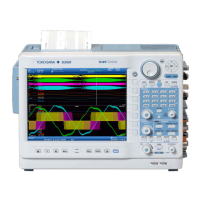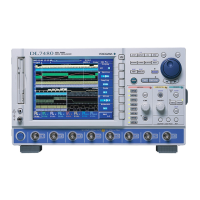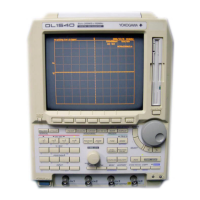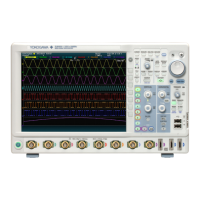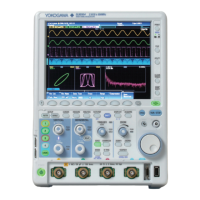10-8
IM DLM6054-01EN
Marker Cursors
Marker cursors move on the waveform data points. You can measure the values at the specified
cursor locations. You can position the marker cursors (MC1 to MC4) on different waveforms.
T1 Time value at MC1
T1-T2 Time difference between MC1 and MC2
T1-T3 Time difference between MC1 and MC3
T1-T4 Time difference between MC1 and MC4
V1 Vertical value at MC1
V1-V2 Difference between the vertical values of MC1 and MC2
V1-V3 Difference between the vertical values of MC1 and MC3
V1-V4 Difference between the vertical values of MC1 and MC4
Serial Cursors
Using the serial cursor position as the reference point, you can search serial patterns (ones and
zeros) in the waveform at the specified bitrate. You can search the entire displayed waveform
(10 divisions). You can specify the threshold value used to separate ones from zeros and specify
whether to associate ones with high or low levels. There are two serial cursors: SC1 and SC2. You
cannot display both cursors simultaneously, but you can display serial patterns simultaneously.
Calculations (Calc)
In all types of cursor measurement other than serial cursor measurement, you can specify
calculations to be made using the measured cursor values and display the results of those
calculations. For information about the types of functions (operators) that you can use in
calculations, see section 9.10. For information about the items that can be measured, see section
10.2.
Cursor Range
D
V Cursors (When the cursor type is
D
V or
D
T&
D
V)
Taking the center of the waveform area to be 0 divisions, you can move the cursors within the range
of –4 to +4 divisions in 0.01-division steps.
D
T Cursors (When the cursor type is
D
T&
D
V,
D
T, Marker, VT, or Serial)
Taking the center of the waveform area to be 0 divisions, you can move the cursors within the range
of –5 to +5 divisions in 0.01-division steps. If a zoom window is displayed and a cursor moves into
the zoom window, you can move the cursor in steps of 0.01 divisions of the zoom window.
10.1 Using Cursors to Make Measurements

